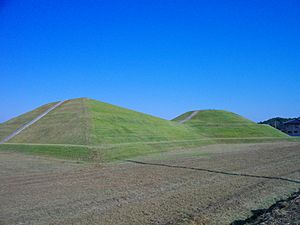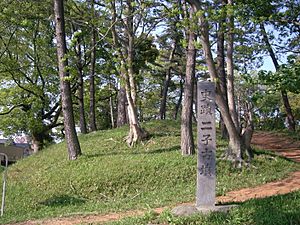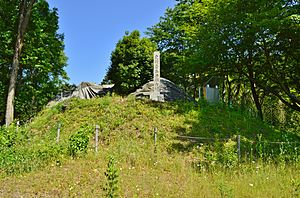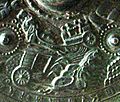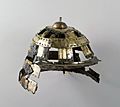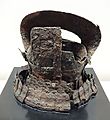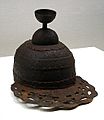Kofun period facts for kids
The Kofun period was an important time in the history of Japan. It lasted from about 300 AD to 538 AD. This era came after the Yayoi period. Sometimes, the Kofun period and the Asuka period that followed are together called the Yamato period. This was the first time Japan's history was written down.
During this period, Japan's culture grew a lot. Ideas and customs from the Korean Peninsula had a strong influence. Experts believe that the cultures of southern Korea and Japan were quite similar then.
The Kofun period also saw Japan's first steps towards becoming a united country. A powerful group called the Yamato clan became strong in southwestern Japan. They created the Imperial Family. They also helped manage important trade routes in the area.
Contents
Kofun Tombs: Ancient Burial Mounds
The word kofun is Japanese. It means the special burial mounds built during this time. These mounds were for important leaders. Archaeologists have found that the tombs and items buried with the elite were very similar across the region. Towards the end of the Kofun period, new ideas arrived from China. These included Buddhism and the Chinese writing system.
Kofun are large earthen mounds. They were built for ruling class members from the 3rd to the 7th centuries in Japan. The Kofun period gets its name from these unique mounds. Inside the mounds, there were big stone burial rooms. Some kofun even had moats around them, like castles!
Shapes and Sizes of Kofun
Kofun came in many shapes. The most common ones were round or square. A very special shape was the keyhole-shape. It had a square front and a round back. Kofun could be small, just a few meters long. But some were huge, over 400 meters long! Pottery figures called Haniwa were often placed around the edge of a kofun. The oldest known Japanese kofun is the Hokenoyama Kofun in Sakurai, Nara. It was built in the late 3rd century.
Studying the Kofun Tombs
For a long time, Japan limited access for foreign archaeologists to study some important tombs. One example is the Gosashi tomb. In 2008, Japan allowed some limited access. There have been discussions about why access was restricted. Some people thought it was to protect secrets about the Imperial Family's history or connections to Korea.
Timeline of the Kofun Period
The word kofun means "burial mound" in Japanese. Here are some key events from this era:
- 416: The first recorded earthquake in Japan happened. It damaged the Imperial Palace in Kyoto.
- 593: Prince Shotoku became a regent. A regent is someone who rules for a child or a ruler who is unable to govern.
- 607: The first ambassadors from Japan were sent to China. Ambassadors are official representatives from one country to another.
Images for kids
-
Keyhole-shaped kofun drawn in 3DCG (Nakatsuyama Kofun in Fujiidera, Osaka, 5th century)
-
Kofun-period jewelry (British Museum)
-
Iron helmet and armour with gilt bronze decoration, 5th century (Tokyo National Museum)
-
Ishibutai Kofun, a late kofun in Nara Prefecture
-
Detail of chariots on a Chinese bronze mirror sent to Japan during the Kofun period. From the Eta-Funayama Tumulus, Kumamoto (Tokyo National Museum)
-
Haniwa soldier in keiko armor
See also
 In Spanish: Período Kofun para niños
In Spanish: Período Kofun para niños



